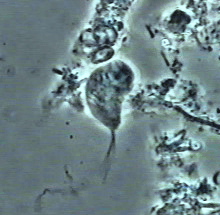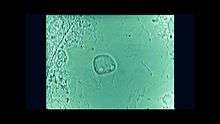Trichomonas tenax
| Trichomonas tenax | |
|---|---|
| Scientific classification | |
| Domain: | Eukarya |
| (unranked): | Excavata |
| Phylum: | Metamonada |
| Class: | Parabasalia |
| Order: | Trichomonadida |
| Genus: | Trichomonas |
| Species: | T. tenax |
| Binomial name | |
| Trichomonas tenax (Müller, 1773) | |

Trichomonas tenax, or oral trichomonas, is a species of trichomonas commonly found in the oral cavity of humans, dogs and cats. Routine hygiene is generally not sufficient to eliminate the parasite, hence its Latin name, meaning "tenacious". The parasite is frequently located in periodontal infections, affecting more than 50% of the population in some areas, but it is usually considered inane. Trichomonas tenax is not found on healthy gums.[1][2] Its presence in necrotizing ulcerative gingivitis (In French, GUN) and necrotizing ulcerative periodontitis (In French, PUN) make it a possible pathogen, worsening the periodontal disease.[3] This parasite is also present in some chronic lung diseases where recovery is brought by removing it (Mussaev 1976). In the same way recovery is achieved by the removal of both, Trichomonas tenax and the amoeba Entamoeba gingivalis.
Almost 90% of advanced periodontal disease has been reported to be found in San Quentin prison at the beginning of the last century.[4] Conditions such as proximity and multiple contacts combined, possibly accompanied by deficient diets seemed responsible for the disproportionate rate. Age is also an important factor (Kofoid and al.1929) and intense inflammation is characteristic.

It is the smallest of the three Trichomonas, 12-20 µm long and 5-6 µm wide, and has a long axostyle and tail, 4 anterior flagella and a recurrent flagellum raising an undulating membrane to two third of the body. It may occasionally appear larger, recalling trichomonas vaginalis. In this specific case, the confirmation of an oral or vaginal parasite should be confirmed since transmission of this kind of parasite most often result of direct contact of mucous membranes.
On very agile appearance, undulating membrane almost seems like small legs.
It lives in the dental calculus, the infected gum disease and purulent tonsillar crypts. T. tenax could be involved in the degradation of periodontal tissue by secretion of various substances such as alkaline phosphatase, and the fibronectin cathepsine as vaginalis.[5] Trichomonas tenax fulfills the requisite of a parasite, causing damage to different mammalian cells and behaving similarly to Trichomonas vaginalis when in contact with target cells in vitro.[6] It has no cysts and is transmitted directly from vegetative form.
Trichomonas tenax can easily be detected by phase contrast microscopy on a fresh mounted smear of periodontal pocket biofilm infection. Preparation must be made on patient salivary medium to prevent warping as running water or saline could provide.
References
- ↑ T. Lyons et al. "Oral amoebiasis: a new approach for the General Practitioner in the diagnosis and the treatment of periodontal disease", Oral Health 1980, 70:39-41, 108, 110.
- ↑ T. Lyons Introduction to protozoa and fungi in periodontal infections. Trevor Lyons Publications, Ontario, Canada 1989. ISBN 0-9693950-0-0
- ↑ Bonner M. To Kiss or Not to Kiss. A cure for gum disease. Amyris Editions, 2013 EAN : 978-28755-2016-6
- ↑ Kofoid CA, Hinshaw HC, HG Johnsotne. "Animal parasites of the mouth and their relation to dental disease," Journal of the American Dental Association 1929 1434-1455
- ↑ Trichomoniasis Trichomonas tenax pleural. Porcheret, Maisonneuve, Esteve, Jagot, Le Pennec. 2002
- ↑ Ribeiro LC, Santos C, Benchimol M. Is Trichomonas tenax a Parasite or a Commensal? Protist 2015
Further reading
Dimasuay, Kris Genelyn B.; Rivera, Windell L.; Fontanilla, Dr. Ian Kendrich C. (April 2014). "First report of Trichomonas tenax infections in the Philippines". Parasitology International. 63 (2): 400–402. doi:10.1016/j.parint.2013.12.015. PMID 24406842. Retrieved 11 February 2015.